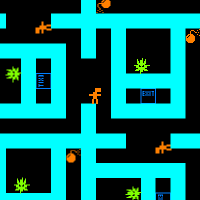Just a collection of some news items about “The Majesty of Colors“:
Monthly Archives: February 2009
Preview of Exploit
I finished my February game a while ago, and I’ve finished the sponsorship process. The game’s called Exploit, but it doesn’t look like it’ll quite be released by the end of February. However, I’ve prepared a video that shows the finished version of the game:
Branching Pathways

I write a lot about agency, the ability for a player to affect the outcome of events in a piece of interactivity. Most games we play have very little high-level agency; the player can determine how a battle is fought, but victory always results in the same outcome. Terry “Xoldiers” Cavanagh just released a game called “Pathways” that plays with the concept of agency. It turns out we don’t have any. Let me elaborate.
Jumpman

I love games that break down conventions to their basic elements and make something new out of them. Joining the ranks of Karoshi 2.0 and Braid is Jumpman, a new game by Andrew McClure that’s been making the rounds lately. It’s got mechanics and aesthetics from the Atari 2600 era, but it’s modern under the hood. I’m not sure if I can succeed, but I’ll try discussing what makes this game interesting.
Puzzle Design in the Myst Series
My latest article is up at GameSetWatch. It’s about puzzle design, and three cases where the Myst series gets it totally right. Read it here.
I freely acknowledge the flaws of the Myst series, but there’s something utterly compelling about these games that nothing else has captured for me. The Ages serve as exploration environments as well as puzzle arenas, and the world has developed quite well, to the point that Uru and its followups require a bit of world knowledge in order to play them. The rules can be determined by experimentation, but it’s handy to know ahead of time that, say, a Link always takes you to the same position in space relative to the planet. And of course, in the Myst universe, “planet” is a very vague term.
I have several other favorite puzzles that didn’t make it into the article. Here are a few of them, in an arbitrary order:
Failure-Friendly Gameplay in Crayon Physics Deluxe
Failing isn’t fun. The way most video games implement failure, it halts the experience and shoves the player out of immersion head-first. In my latest article for GameSetWatch, I discuss the way Crayon Physics Deluxe embraces failure. Go read “Failure-Friendly Gameplay in Crayon Physics Deluxe.”
Preview The Fool
In 1987, a man named Cliff Johnson (no relation to the Aperture Science CEO) released a game called The Fool’s Errand, which you can download for free here. Warning: this is the cruelest game ever made. It isn’t cruel because it is unfair or impossible; it’s cruel because it makes very clear that you can beat it, if only you were a little bit smarter. Countless logic, word, and visual puzzles all feed into one enormous meta-puzzle that draws on clues from the entire game. It’s a labor of sadistic and megalomaniacal love, and chances are good that you, like me, are simply not clever enough to beat it.
It’s been 21 years since The Fool’s Errand. A sequel was originally supposed to come out in October 2003. Some people have had the sequel pre-ordered for five years. And Johnson just released a demo of The Fool and His Money. You can download it from the “Teaser” links at the bottom of that page.
This is a game from another world, where people are smarter and more masochistic and entirely disinterested in the normal mapping of giblets. Has Johnson succeeded in reproducing his fiendish masterwork? Well… I’m stumped.
Simulation, Structure, and Agency

And now for some hardcore interactivity theory geekery. I’ve been doing design for my current work in progress (working title: The Mold Fairy) and it’s caused me to think, as I often do, about the nature of interactivity. Most any interactive work is a simulation. Usually, this is a simulation of reality, or of a reality very similar to our own; two to three dimensions, strict sequencing of time, the possibility of containment and spacial relations, and various energies and forces. Different games have different levels of abstraction to their simulation. What makes it interactive is that the player can tweak the parameters of the simulation. In most games, the player can only control the behavior of an actor or group of actors within the simulation. This ability to affect the progress of the simulation is called player agency. It’s essential to interactivity, and it’s used in different ways in different works. I’d like to see this agency take a different form than it usually does. Let me lay some groundwork first.
Fan Art!
I think the mark of true success is when someone makes fan art of your work:

The Majesty Of Balloons by ~dangertable on deviantART
What’s next? Rule 34?